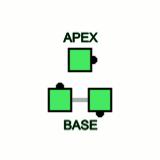
Since a full square consists of eight dancers, the caller will typically be addressing triangle calls to two groups of three dancers – a total of six dancers – while two other dancers will not be involved.
In addition, many eight-dancer formations contain more than one pair of triangles. So the first task of the caller is to make clear which pairs are to do the call (which also tells the dancers which two dancers are not involved) – and the first task of the dancers is to understand this. The process of identifying the triangles, and the terminology used in doing that, is referred to as "triangle identification".
Once dancers understand if they are in one of the relevant triangles, their remaining task is to do the action of the call. At C-1, the call will almost always be a circulate (i.e., Triangle Circulate). There are other calls relating to triangles that are introduced in later programs, and a few other simple things that can be done with triangles in the same way as other subformations (e.g., Counter Rotate, Substitute), but mostly what you need to learn to do, with triangles as such, is how to circulate in them.
General Rule: On a triangle circulate, each dancer moves to the next spot, based on his/her own current facing direction. Note that for all three dancers to be able to do this, without trying to occupy the same spot, they must all be moving around the triangle in the same direction – clockwise or counterclockwise. Another way of saying this is that they all have the same shoulder toward the center of the triangle. (Such triangles can therefore, in the same way as with boxes and diamonds, be referred to as "left-handed triangles" or "right-handed triangles".) There can be triangles for which this is not the case, but if the caller is going to ask you to circulate in a triangle it will almost always be one where everybody has the same shoulder into the center.
One shoulder of the apex dancer is facing directly at the center point between the two base dancers – in the same way as a point of a diamond has one shoulder toward the hand-hold between the two center dancers. This also means that the apex dancer is exactly the same distance from each of the two base dancers. (If you imagine the geometric shape consisting of lines connecting each pair of dancers, and you remember the terminology used in your high school geometry class, another way of saying this is that the shape is an isosceles triangle.)
On a triangle circulate in the case of a wave-based triangle, as each dancer moves to the next spot he or she adopts an appropriate facing direction so that the triangle will still be a wave-based triangle, while keeping the same shoulder toward the center.

Considering each of the three segments of this circulate path separately:
Note: If the base consists of two dancers standing side by side and facing the same way (i.e., a couple), the triangle is still referred to as "wave-based". In such a triangle the dancers would not normally be asked to do an ordinary Triangle Circulate, but the term "wave-based triangle" is still useful to be able to identify the group of three dancers and ask them to do something else.
As with wave-based triangles, the general rule is that each dancer moves to the next spot while keeping the same shoulder toward the center, and for all three dancers to do this without trying to occupy the same spot they all must have the same shoulder toward the center. And when doing a circulate in a tandem-based triangle, each dancer must adopt an appropriate facing direction so that the triangle will still be tandem-based.
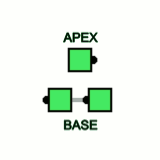
Considering each of the three segments of the circulate path separately:
Note that two of the segments involve turning 180 degrees, and that the apex dancer must do this while also moving forward, with respect to his/her original facing direction. A common mistake is for this dancer to move to the correct spot but forget to turn around (i.e., just slide diagonally into that base spot). A good way to avoid this mistake is to focus on the basic rule: you must keep the same shoulder toward the center of the triangle.
Note: If the base consists of two dancers facing each other or back to back, the triangle is still referred to as "tandem-based". In such a triangle the dancers would not normally be asked to do an ordinary Triangle Circulate, but the term "tandem-based triangle" is still useful to be able to identify the group of three dancers and ask them to do something else.
First, let's review the kinds of terms most commonly used, then we'll look at how they apply in the context of common eight-person formations.
There can be other variations, but these examples illustrate the basic approaches.
Also note that even when one kind of identification would be enough to uniquely identify the pairs, callers sometimes use more than one just to be helpful. So you might hear something like "Outside Wave-Based Triangles", even though there are no tandem-based triangles so just "Outside Triangles" would have had the same meaning.
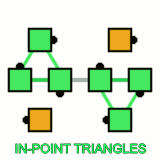
There are, however, also other pairs of wave-based triangles – the ones formed by the two points of one diamond and one of the centers of the same diamond. These are almost always identified using the "Outside / Inside" terms.
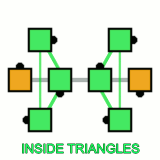
Note that the "base" in these triangles is very wide, with a large gap between the two dancers making up the base. In addition, right in the middle of that gap there is a hand-hold (between the centers of the diamond). Circulating in such a triangle is therefore somewhat awkward – the centers of the diamond must release their hand-hold, one of the base dancers then has to walk a considerable distance while remembering to turn around half way, and then the new apex has to remember to join hands again with the other center of the re-formed diamond – and for this reason these triangles are much less commonly used. But they get used frequently enough that you do need to understand that they exist.
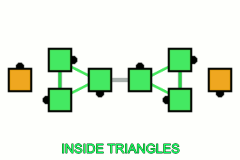
There are also pairs of "wide" wave-based triangles, consisting of both points and one center, but these are far less commonly used. When they are they might be identified by a term like "Out-Center Triangles".
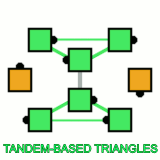
There are actually more triangles that can be identified, for example by considering one of the very centers to form a tandem-based triangle with the far two outer (point) dancers, but additional words are needed for that, so to identify the obvious pairs normally just "the wave-based triangles" or "the tandem-based triangles" will be enough.
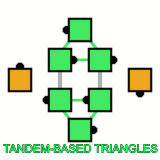
There are actually more triangles that can be identified, for example by considering one of the points of the outer diamond to form a wave-based triangle with the far two center dancers, but additional words are needed for that, so to identify the obvious pairs normally just "the wave-based triangles" or "the tandem-based triangles" will be enough.
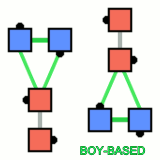
Alternatively, the caller might make use of the fact that these pairs of triangles have different handedness. So in this example "the left-handed wave-based triangles" would refer to the same pair as "the girl-based triangles".
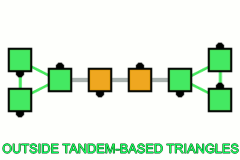
But in other cases, the caller may need to use terms normally associated with some other formation to identify the specific triangles, even though the dancers aren't facing in a way that would normally make up such a formation.
For example, if the dancers are on spots that would normally make diamonds, but the centers are facing the same kind of wall as the ends, the caller might refer to "In-Point Triangles" even though the term "point" might not otherwise be used for the ends, and even though these triangles are tandem-based (while the in-point triangles in actual diamonds are wave-based).

Remember: The purpose of "triangle identification" is just to tell you which triangles should be doing the call. Don't worry too much about the exact words the caller uses to do that. Once you have become familiar with the commonly-used terms, even if the caller combines them or has to make up a new one for some odd situation, the meaning should be pretty obvious. And once you have figured out whether you are in a triangle that should be doing the call, the words that were used to identify it don't affect how you actually do the call.